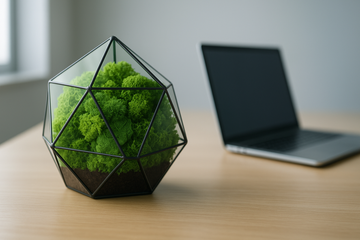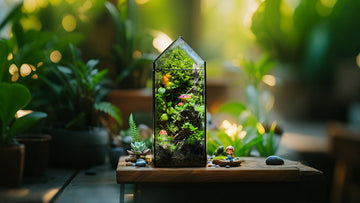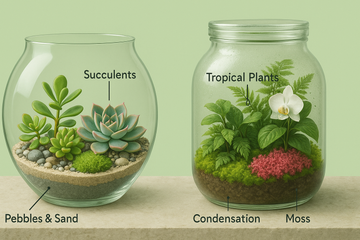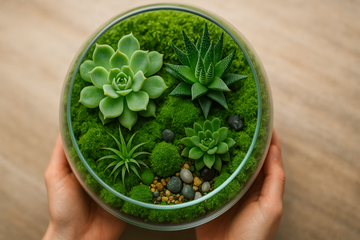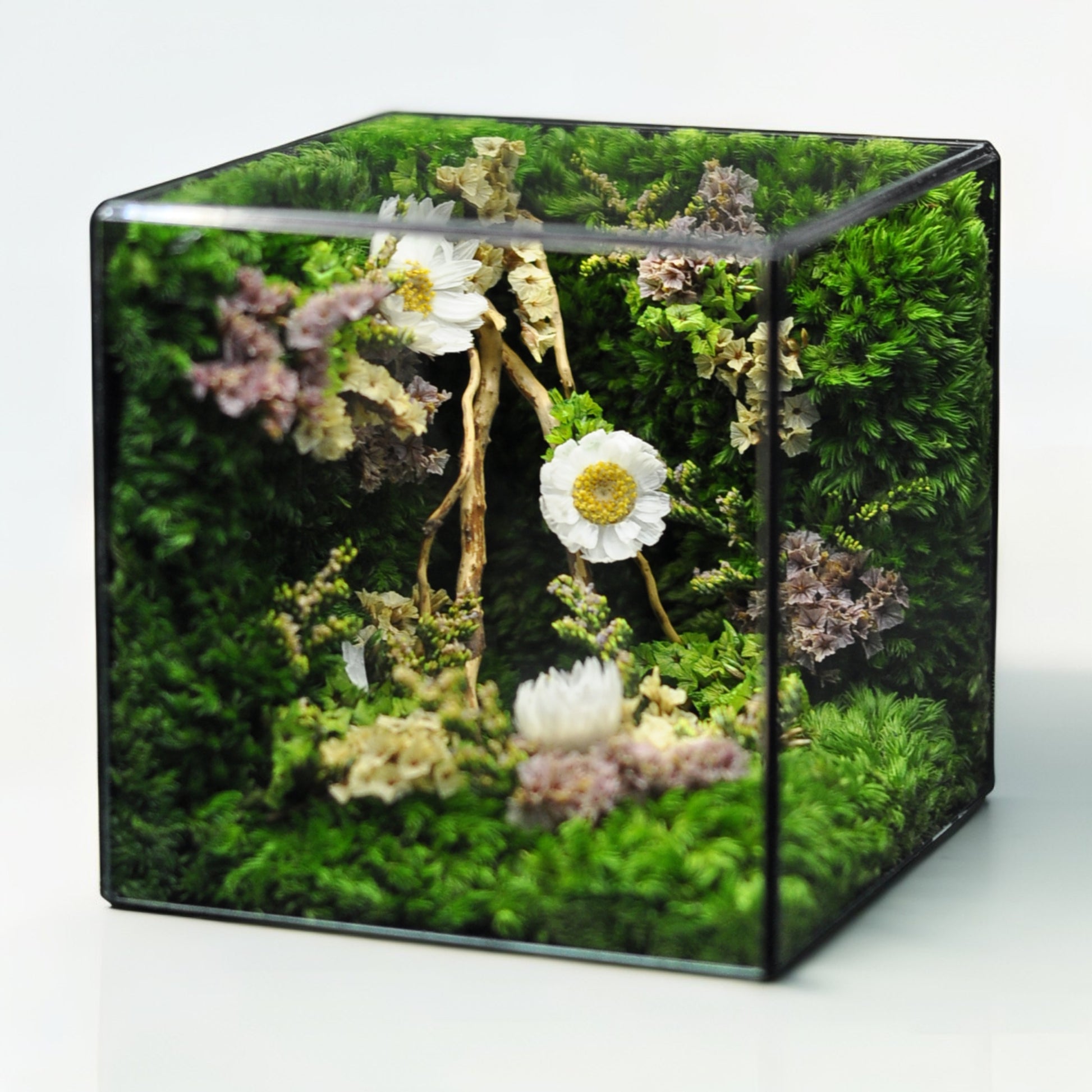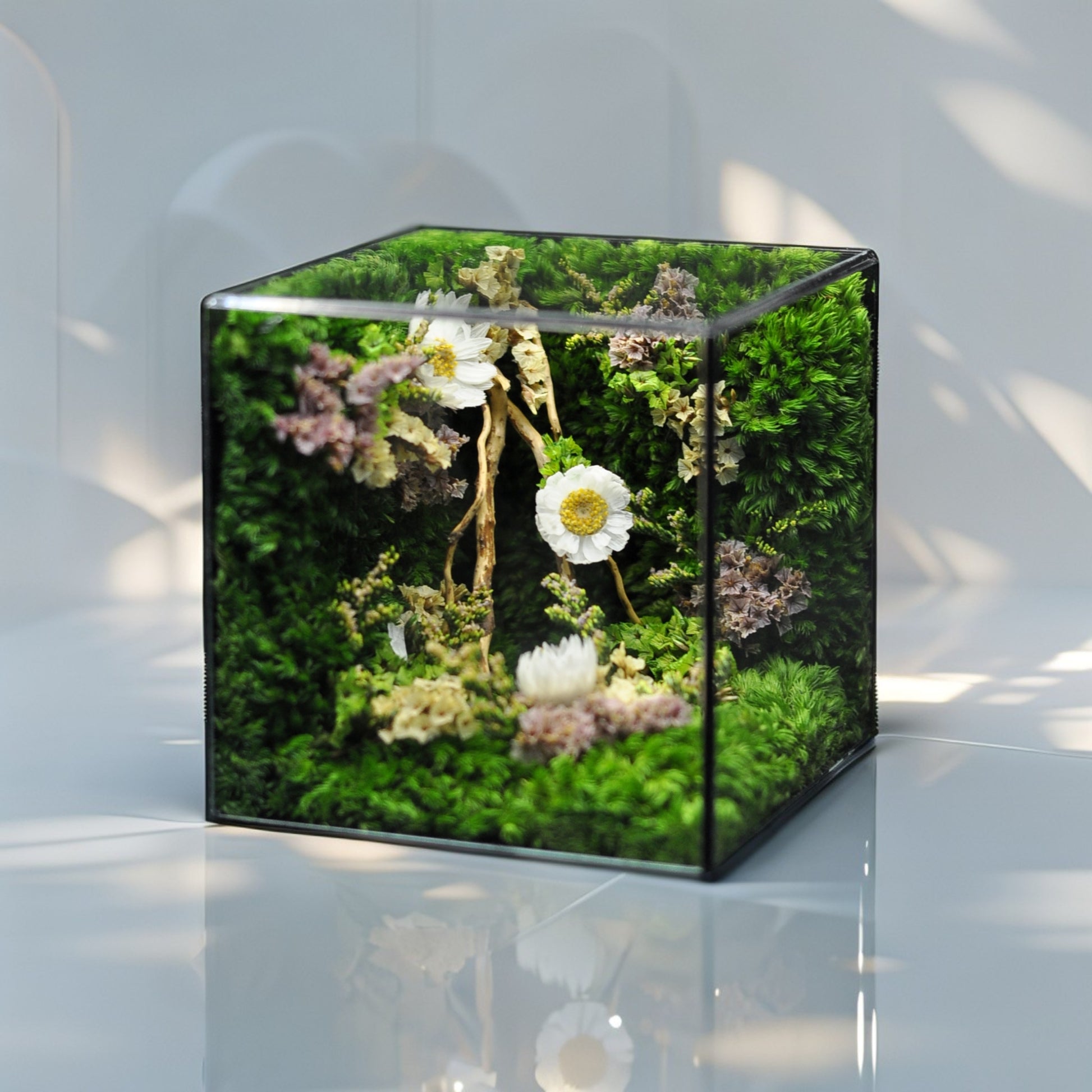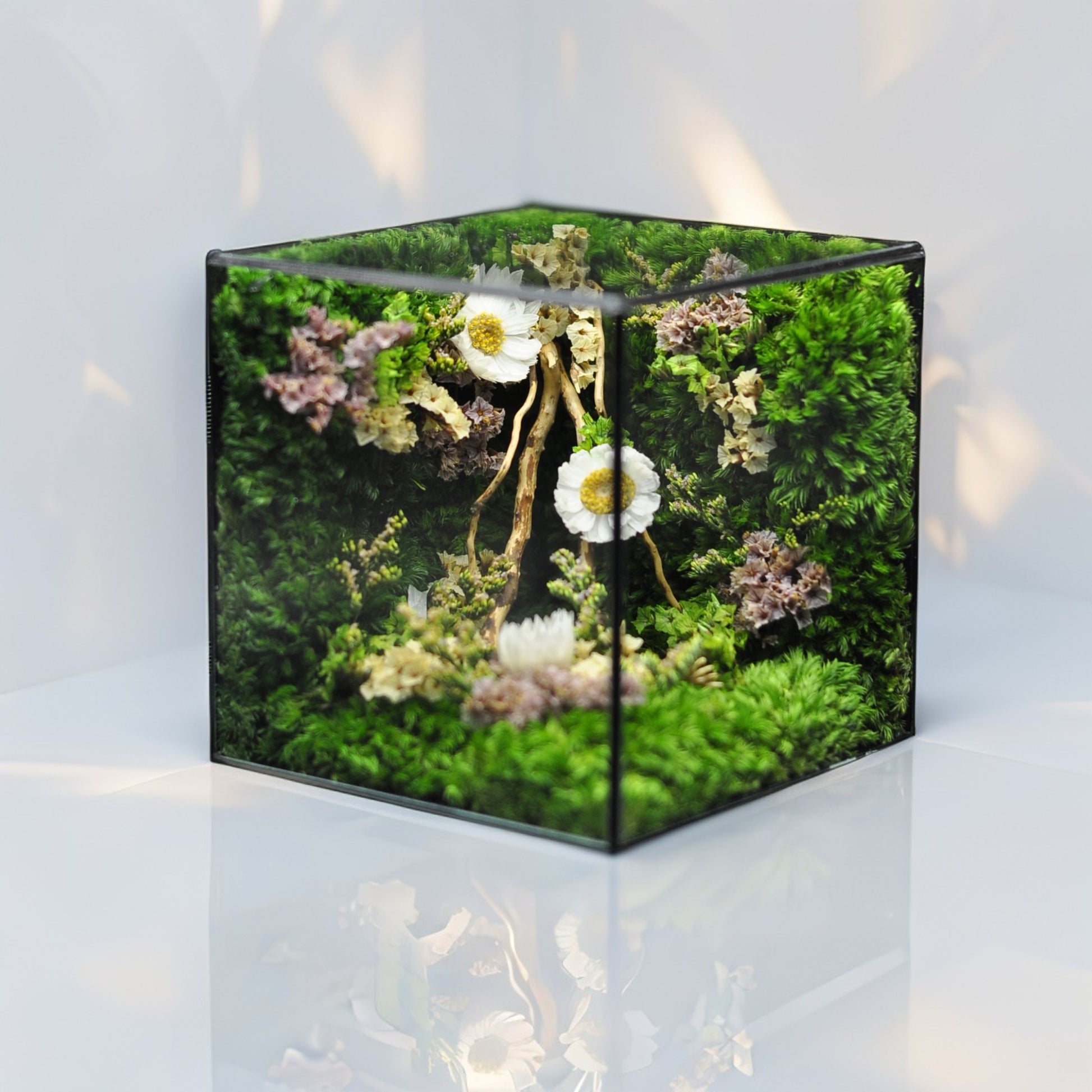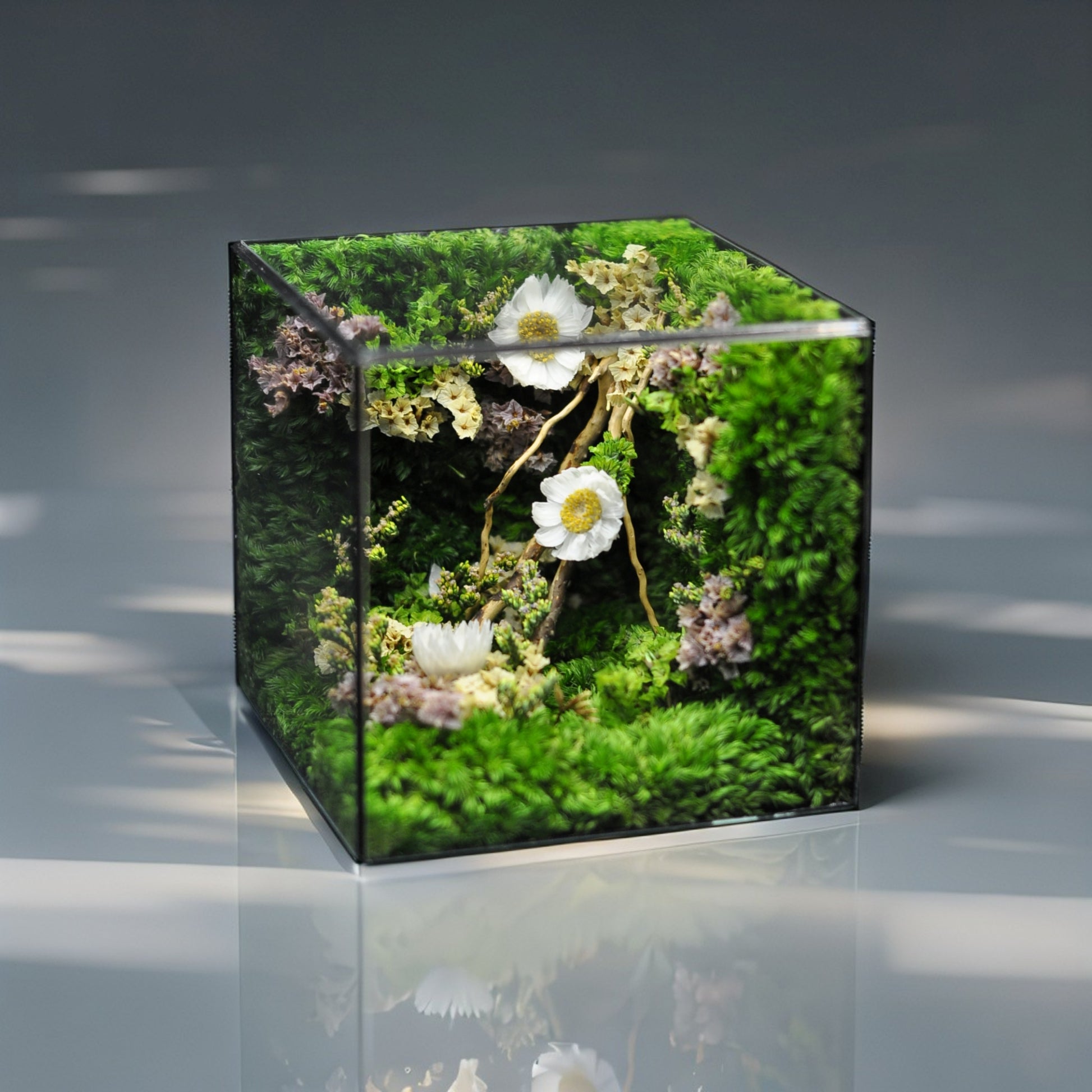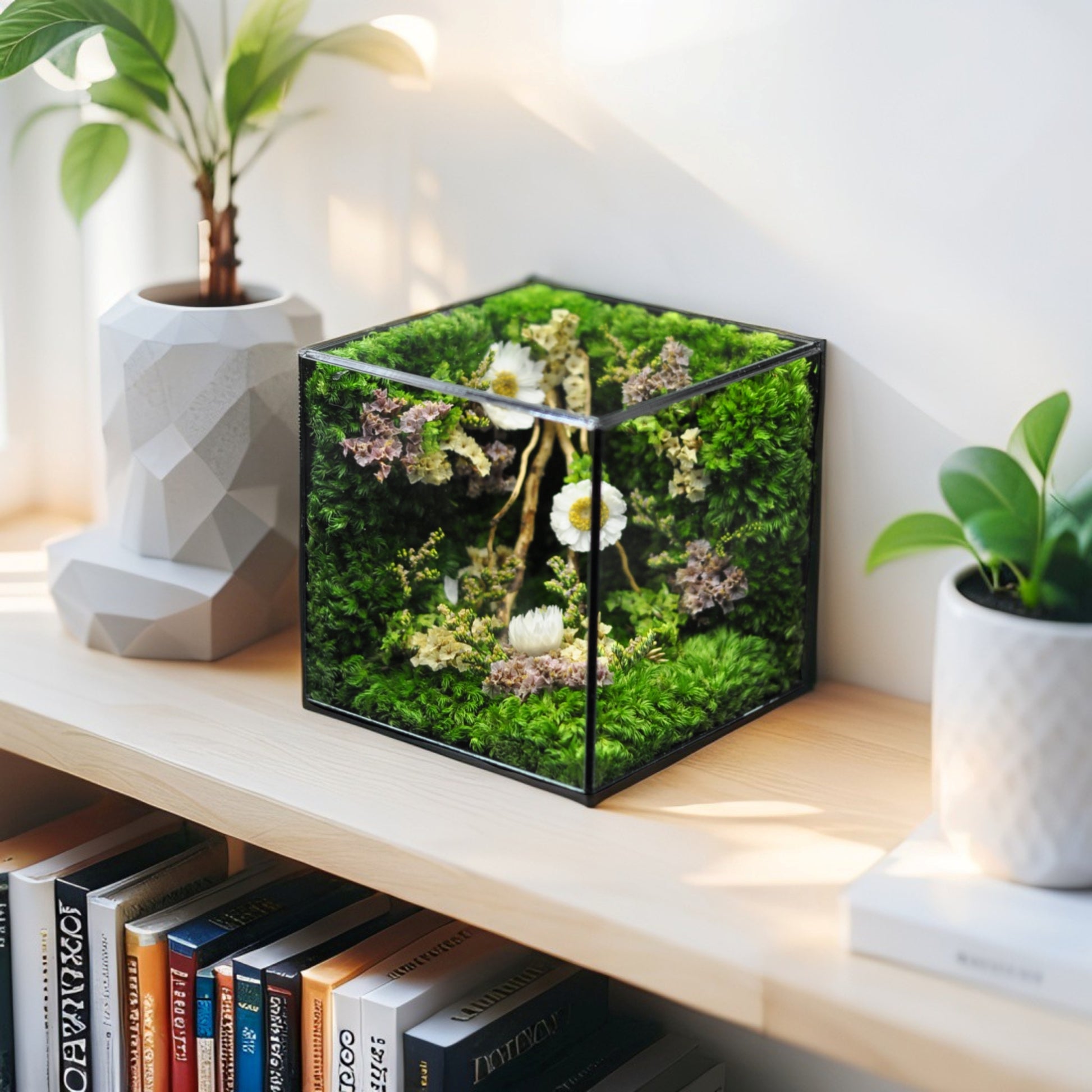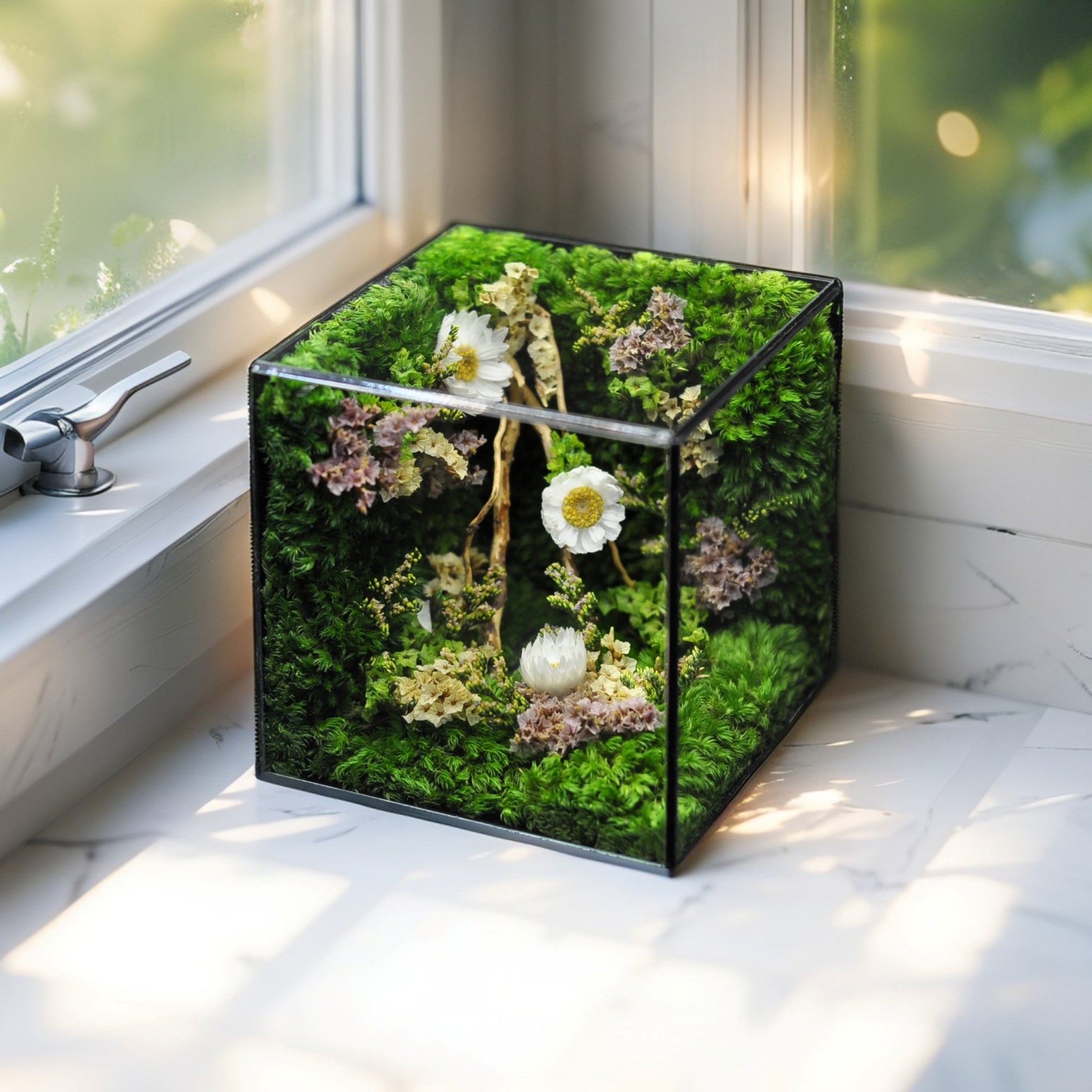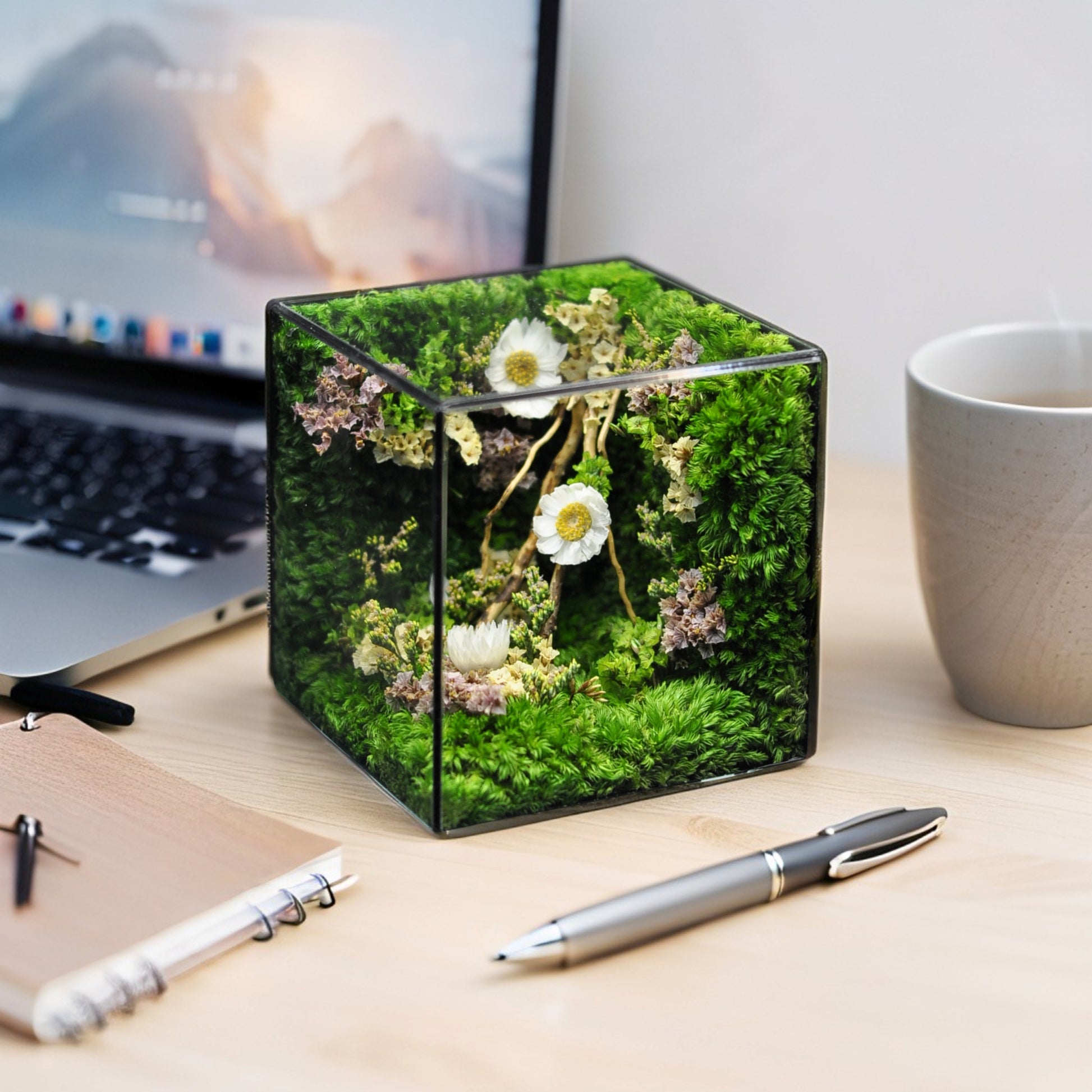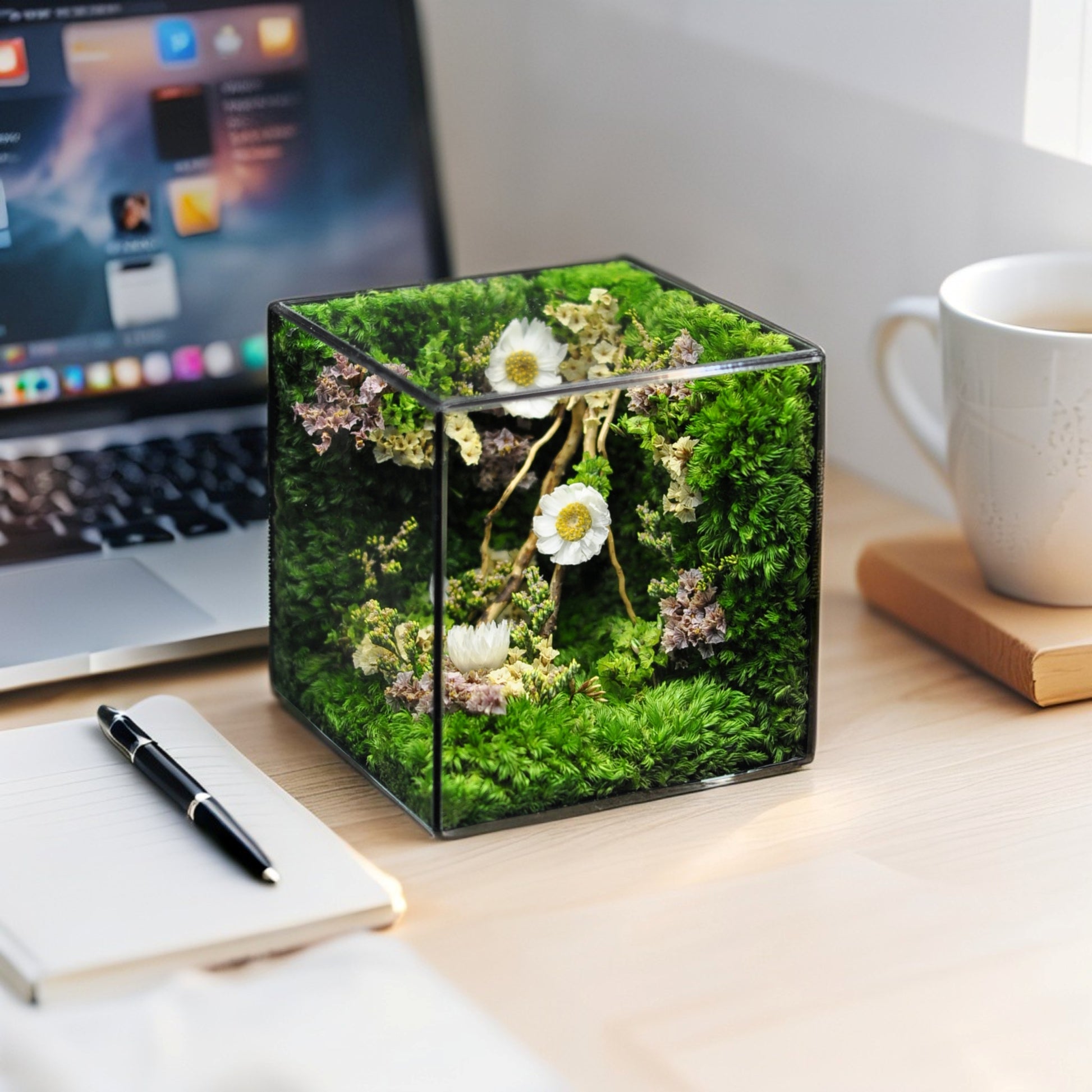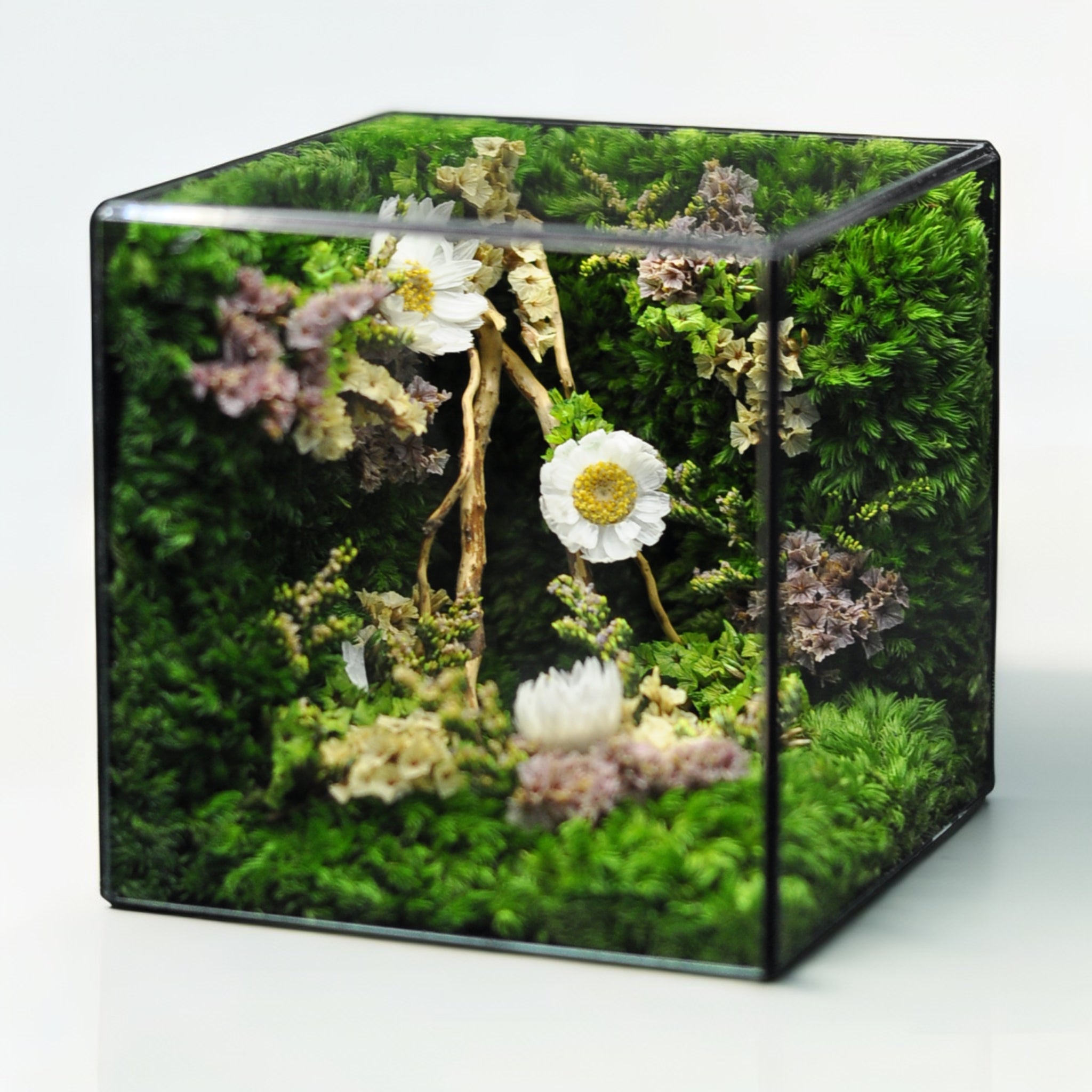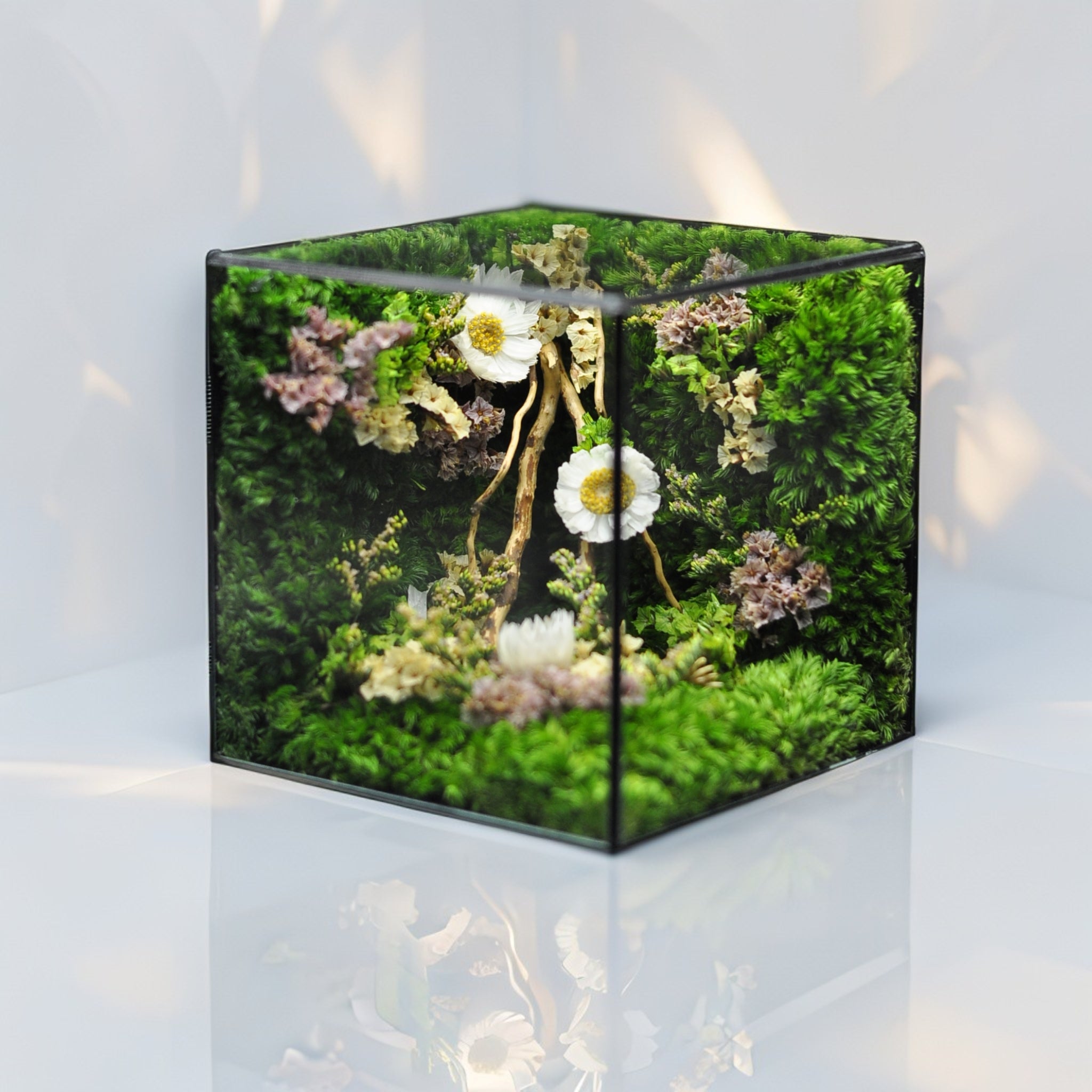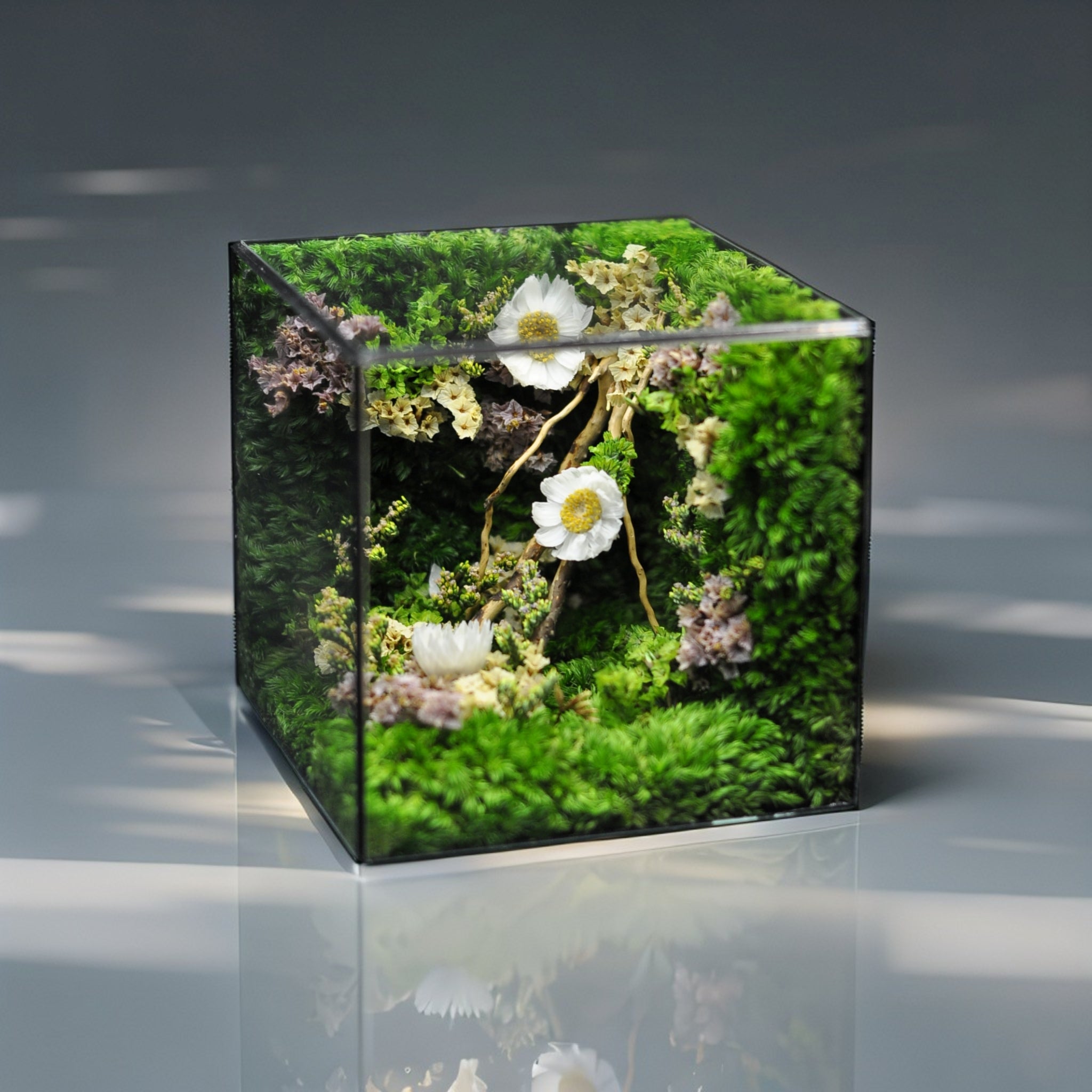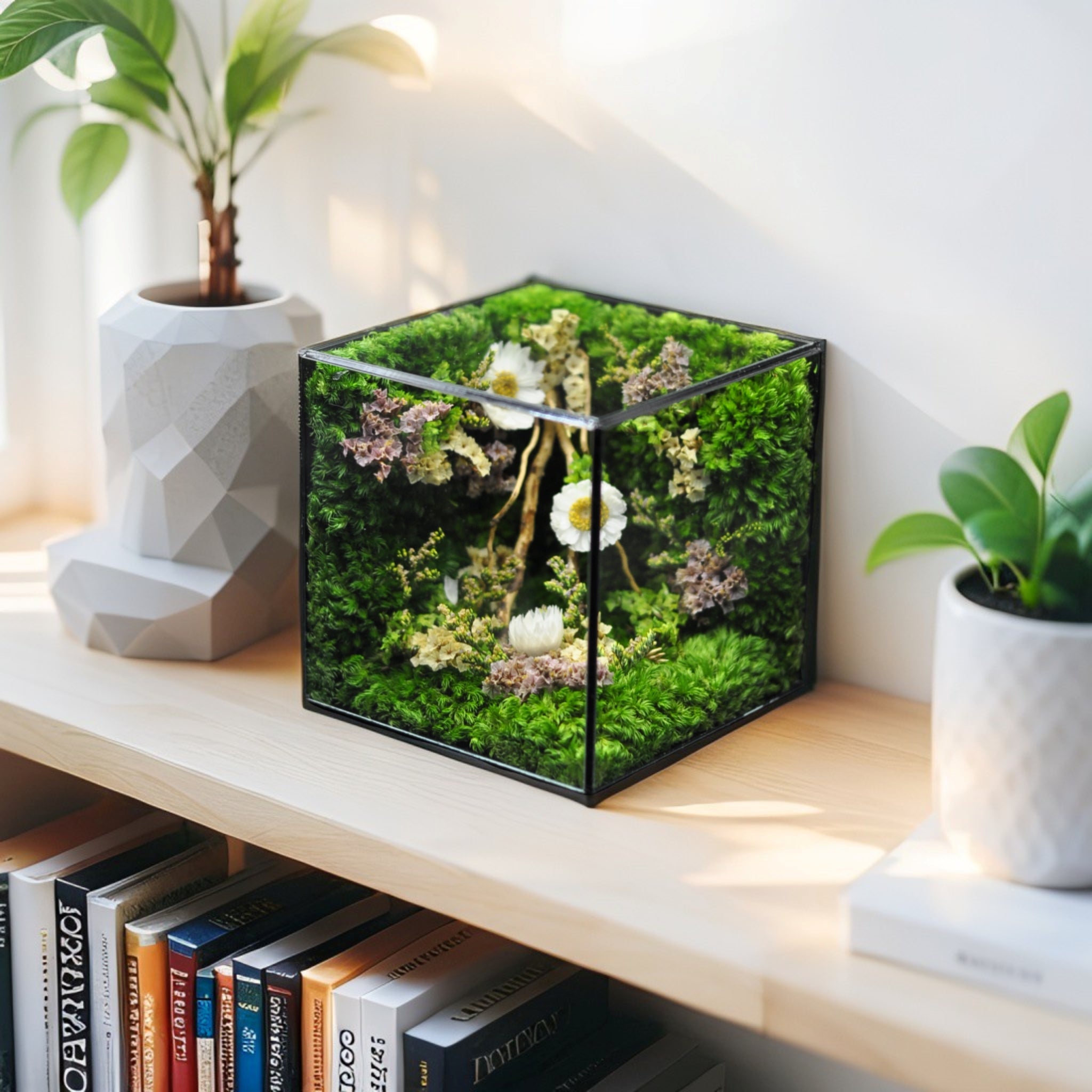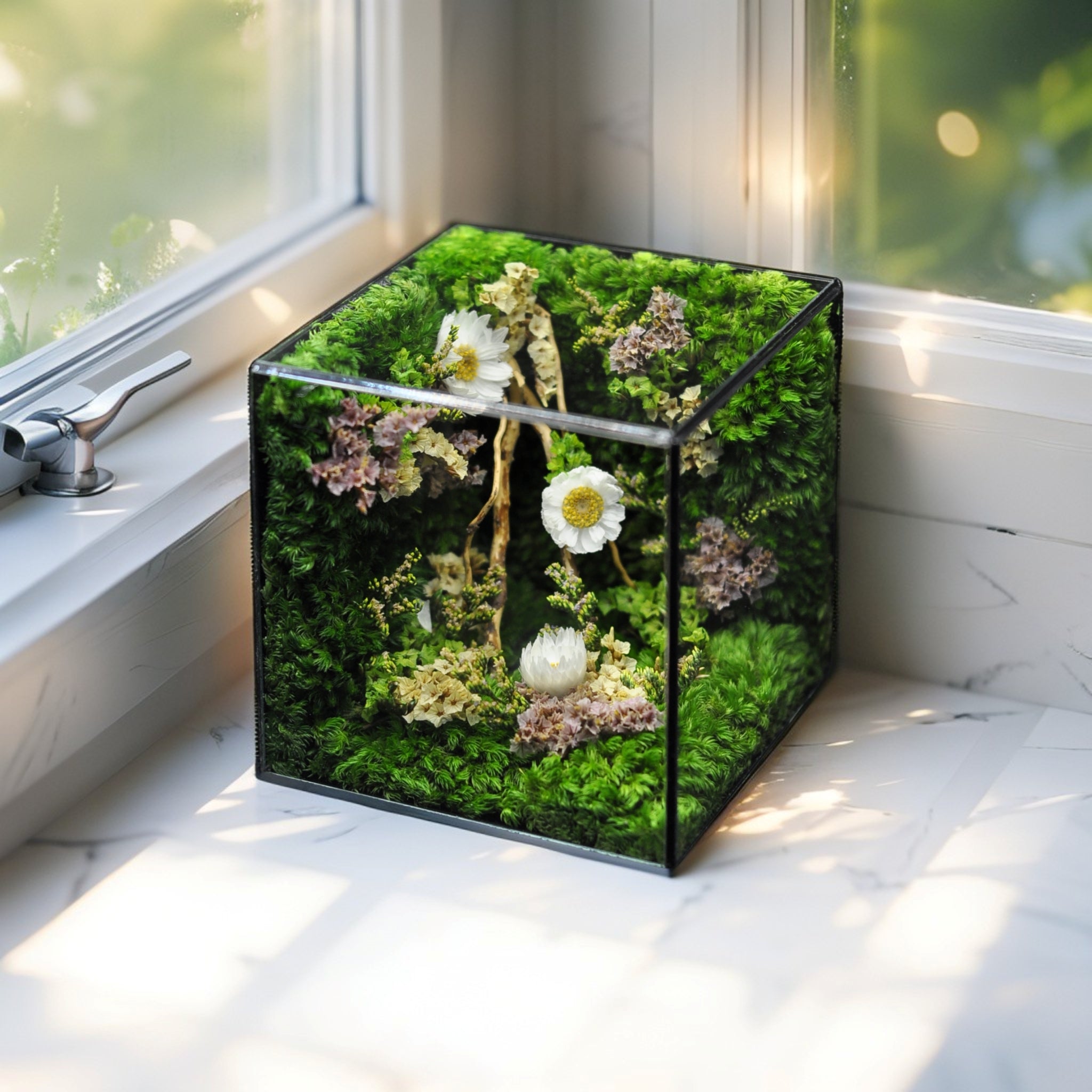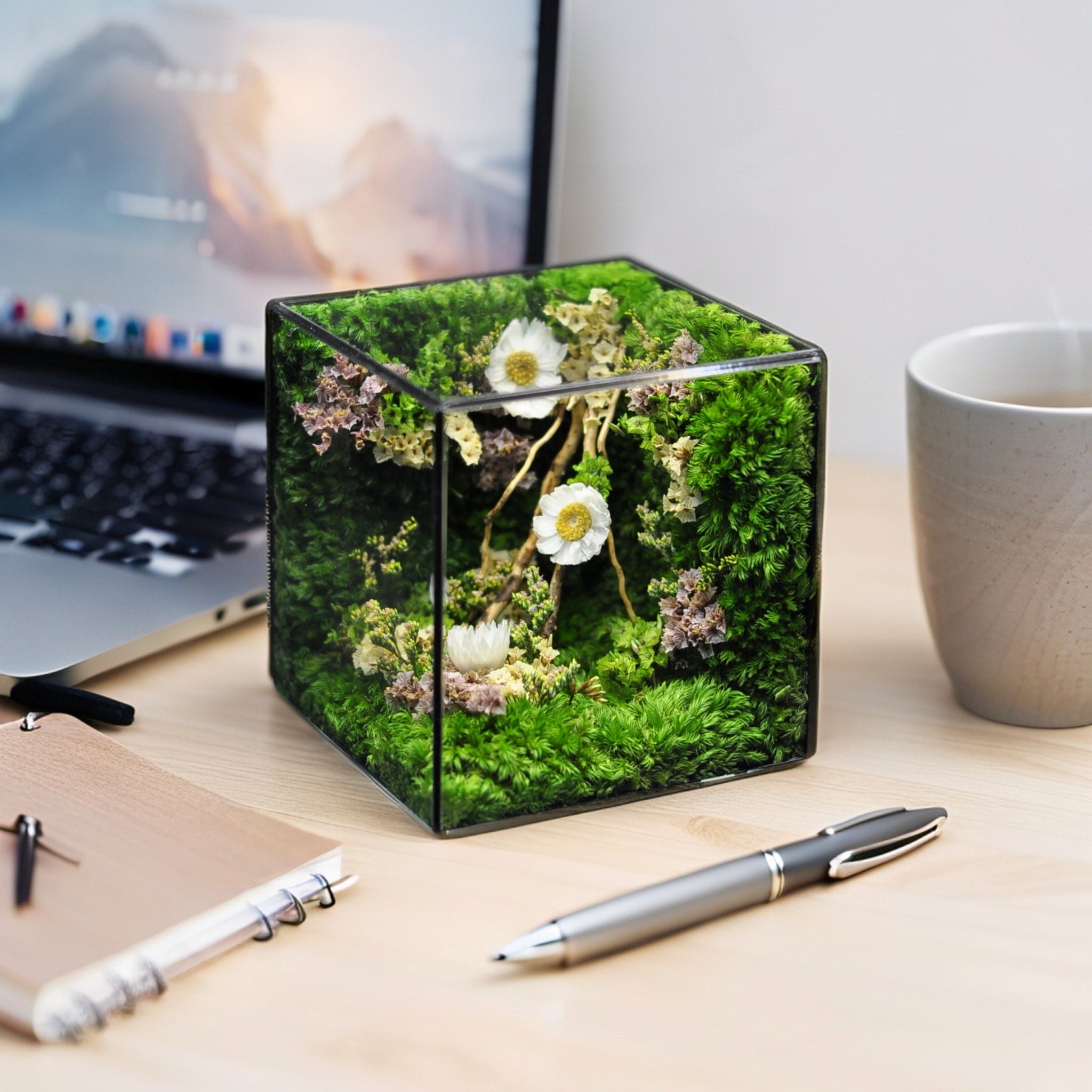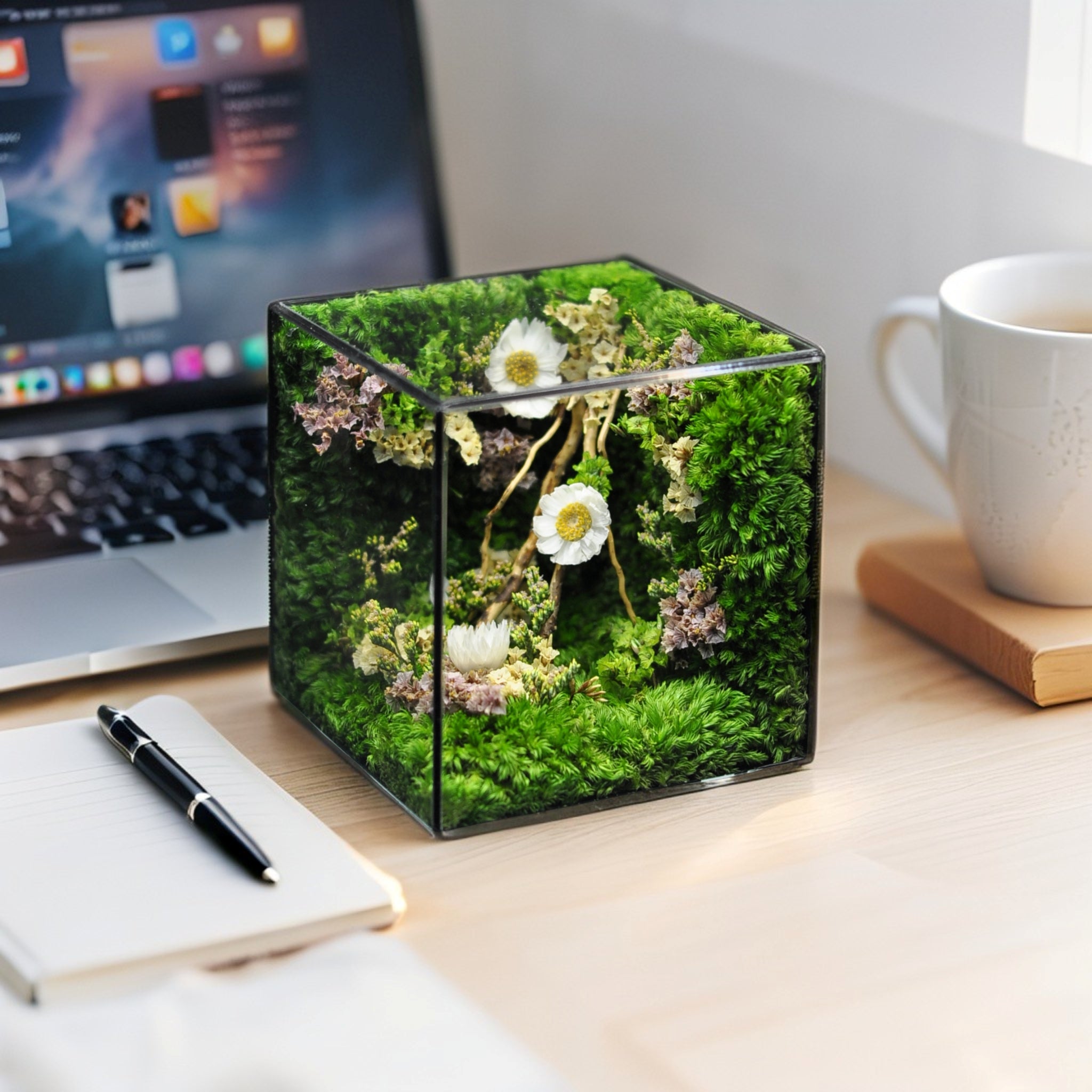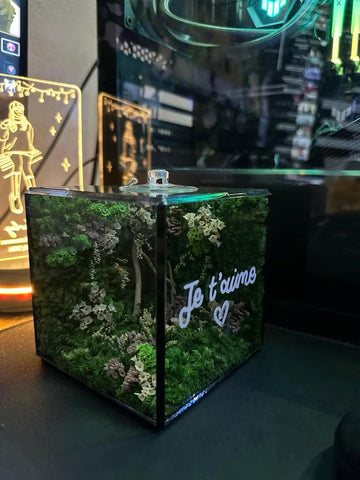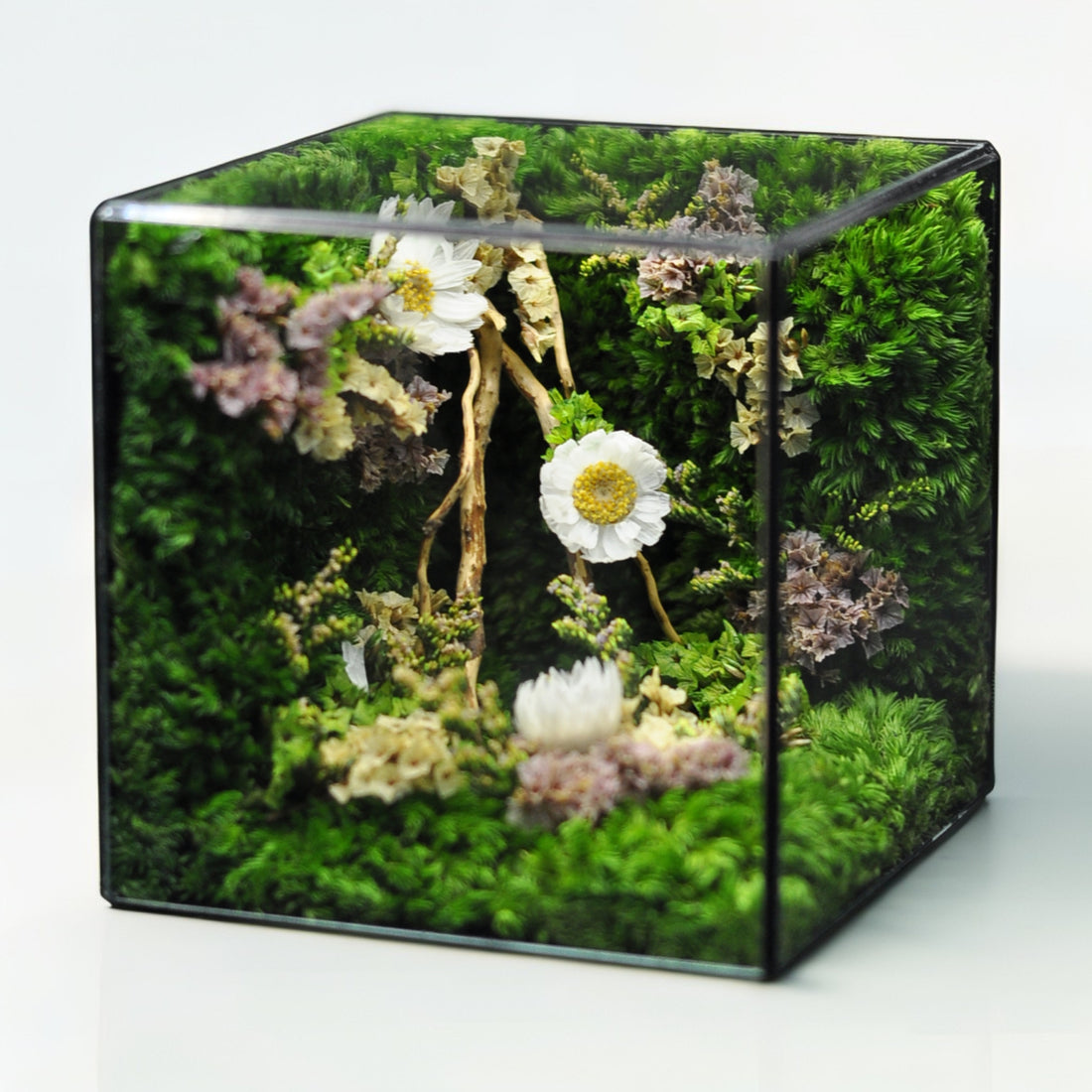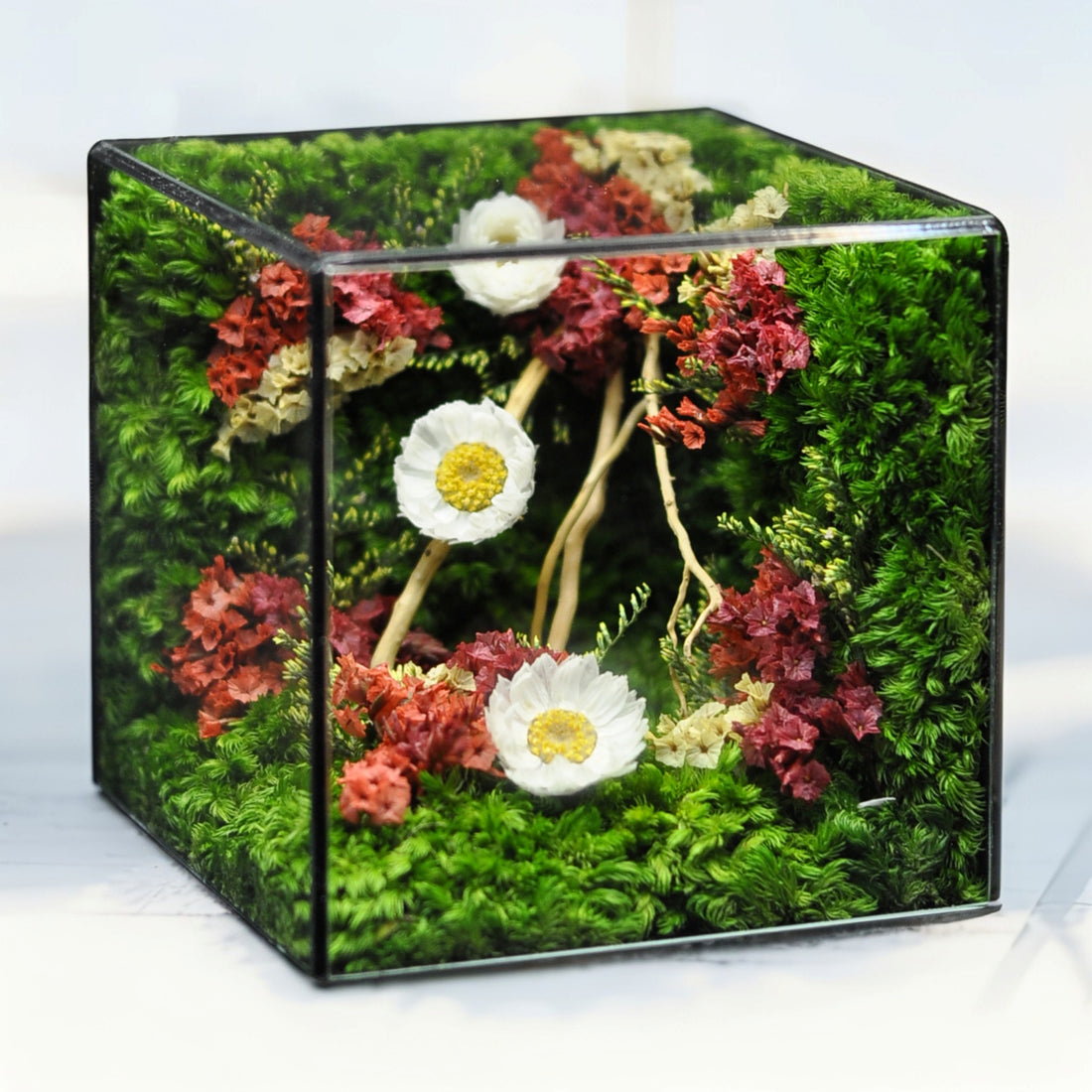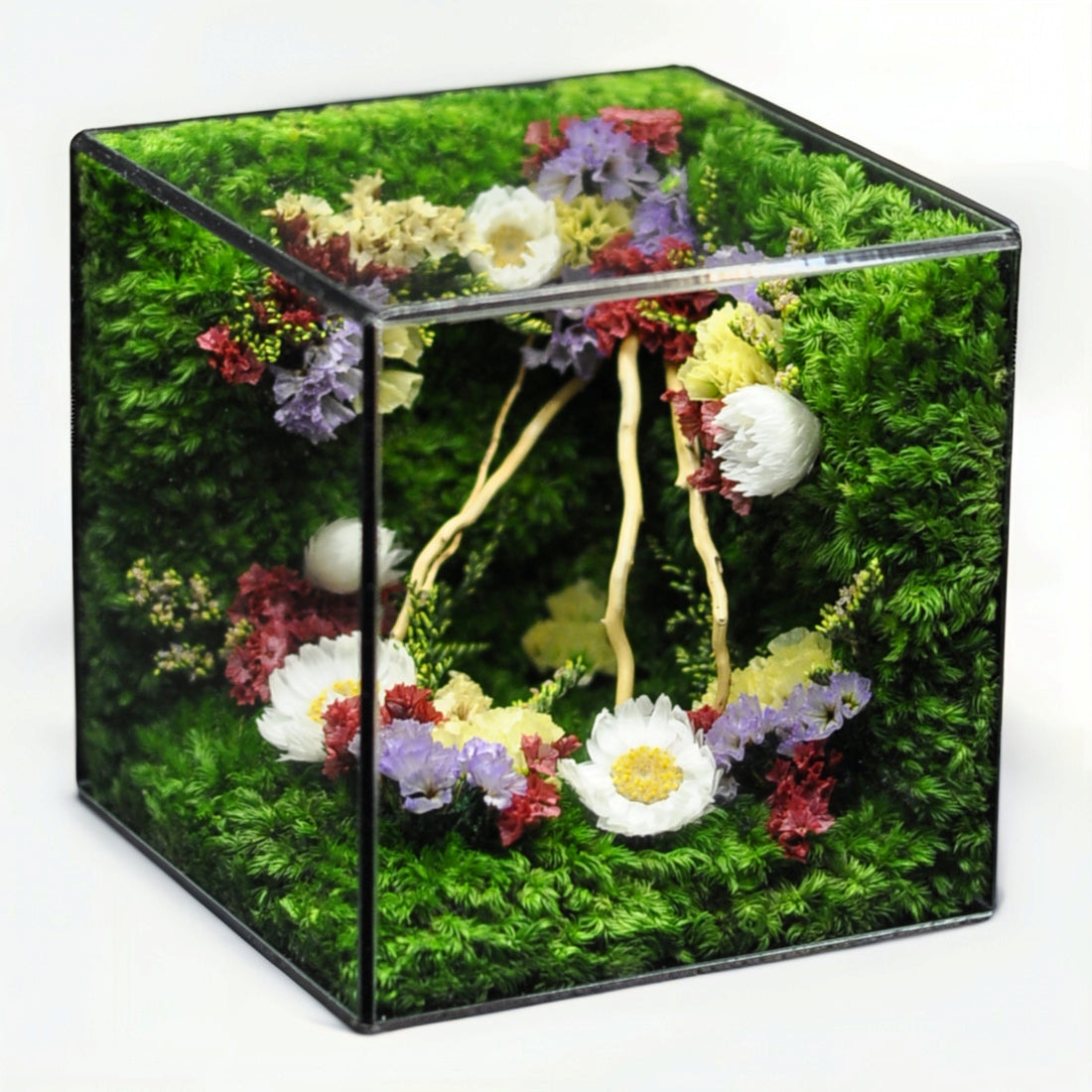Key Takeaways
- Embrace zero-maintenance greenery: Unlike live plants, preserved terrariums require no watering, sunlight, or pruning, offering effortless beauty year after year.
- Enjoy lasting natural beauty: Crafted from real, specially treated plants like moss and ferns, these terrariums retain their vibrant color and texture indefinitely with minimal fading.
- Unlock your inner artist with DIY: Beyond buying, create custom designs by arranging preserved moss and other elements, offering a unique avenue for creative expression using simple techniques like careful gluing.
- Find your perfect indoor landscape: Preserved terrariums come in various styles and sizes, making it easy to find unique pieces that complement any home or office decor.
- Decorate any space without worry: Their self-contained nature means you can place them anywhere – desks, shelves, bathrooms – without needing to consider light or humidity conditions.
Dive deeper into the world of preserved terrariums to explore where to shop for these low-maintenance botanical wonders, how they compare to live alternatives, and gather inspiration for bringing everlasting green art into your life.
Introduction
Imagine a miniature forest thriving on your desk—no watering, no pruning, no light worries. Crafted from real, specially treated moss and ferns, a preserved terrarium locks in nature’s textures and hues indefinitely.
These self-contained green worlds bring lasting beauty to any space, making them perfect for busy lifestyles. Whether you’re scouting for ready-made designs, exploring DIY mossarium projects, or seeking styling ideas to complement your decor, this guide to preserved terrariums covers everything you need to know. Let’s explore how to shop, style, and even craft your own zero-maintenance indoor garden.
Preserved Terrariums: Evergreen Décor Without the Effort
Ever dreamed of a miniature forest that never wilts? Imagine emerald carpets of moss cradled in glass, whispering serenity beside your morning coffee—no watering required. Welcome to the world of preserved terrariums, where living color meets zero-maintenance ease.
What Is a Preserved Terrarium?
Definition and Core Components
A preserved terrarium is an open or sealed glass vessel showcasing botanical elements—mosses, ferns, lichens, even small branches—treated to retain their fresh-picked appearance indefinitely. Unlike living terrariums, these preservation displays contain no soil or active roots. Instead, botanical materials undergo a stabilization process that locks in moisture, texture, and hue.
Preservation Process Overview
-
Harvest and Drying
Freshly harvested moss is gently air-dried or briefly oven-dried to remove surface moisture without browning. -
Stabilization Infusion
The dried moss soaks in a non-toxic glycerin solution (a hygroscopic binder) often mixed with water. Glycerin replaces cellular moisture, keeping fibers supple. -
Optional Dye Application
Food-grade or plant-safe dyes may be added for uniform color intensity—ideal for custom palettes. -
Vacuum Treatment
Some artisans use a vacuum chamber to accelerate infusion, ensuring deep penetration of stabilizer. -
Curing and Quality Check
Treated moss rests until fully absorbed (12–24 hours), then experts inspect pigment uniformity and texture.
Glycerin-based stabilization is considered eco-friendly and non-toxic for indoor use; look for USDA-certified or non-GMO labels when choosing moss.
Common Preserved Moss Types and Mossarium Styles
- Sheet Moss (Hypnum): Flat, carpet-like surface—perfect for backgrounds.
- Reindeer Moss (Cladonia rangiferina): Spongy, 3D texture—ideal for sculptural highlights.
- Forest Moss (Dicranum): Dense, tufted appearance—adds depth and shadow.
- Stabilized Lichen: Delicate, branching form—used as accent or filler.
Styles range from hanging glass orbs and geometric frames to shadow boxes and resin-encased art panels. With components in place, let’s explore why preserved terrariums have captured the hearts of low-maintenance decor lovers.
Benefits of Preserved Terrariums
Zero-Maintenance Greenery: Ultimate Low Maintenance Decor
Say goodbye to watering schedules and plant worries. Preserved terrariums thrive without light, humidity control, or pruning—ideal for busy professionals and frequent travelers. They resist mold, pests, and seasonal browning, delivering perpetual freshness.
Everlasting Terrarium Aesthetic: Color and Texture Retention
Thanks to glycerin and high-quality dyes, preserved moss holds color for up to five years under optimal conditions (indirect light, 60–75°F). Under typical indoor environments, expect vivid greens for 2–3 years. A national bank chain replaced live plants in 200 branches with mossariums, cutting maintenance labor by 75% and saving an estimated $5 million annually, according to the 2021 GreenScapes Facilities Report.
Versatile Indoor Garden: No Light, Water, or Humidity Concerns
Place a preserved terrarium in windowless offices, dim hallways, or humid bathrooms without fear. The stable moisture level and closed design mean your mini forest stays lush even in unconventional spots. GreenSpace Interiors outfitted a coworking hub with 50 mid-sized terrariums from an online eco-shop, reducing plant-care calls by 90% in six months, according to company data.
With these advantages in mind, let’s see how preserved terrariums stack up against live plant displays.
Preserved Terrarium vs Live Terrarium
Maintenance Comparison: Watering, Sunlight, Pruning
- Preserved Terrarium: Zero watering, no light requirement, no trimming—simply dust occasionally.
- Live Terrarium: Requires regular misting or irrigation, indirect sunlight, trimming to prevent overgrowth, and risk of mold if overwatered.
Longevity and Cost Analysis
- Upfront Costs: Live terrariums start at $30; preserved versions begin around $40 for small pieces.
- Ongoing Expenses: Live moss demands soil, fertilizers, and occasional pest control—annual costs can reach $50–$100. Preserved moss needs no supplies for years.
- Lifespan: Live setups may last 6–12 months before replanting. Preserved scenes endure 2–5 years, with replacement costs limited to occasional glue touch-ups.
Aesthetic and Tactile Differences
- Live Moss: Soft, variable textures; dynamic growth; slight scent.
- Preserved Moss: Consistent color, firm yet pliable feel, no scent, and greater sculptural potential.
Mossariums balance the charm of living gardens with the reliability of art installations. Next, discover how to craft your own preserved moss terrarium.
DIY Preserved Moss Terrarium (Mossarium)
Materials and Terrarium Kit Options
Full DIY Kit Includes:
- Clear glass container (with lid or open top)
- Mixed preserved moss (sheet, forest, reindeer)
- Botanical glue or spray adhesive (non-toxic)
- Tweezers, small paintbrush, disposable gloves
- Step-by-step instruction guide
Pre-Assembled Kits (Starter Kits):
- Container, one moss type, adhesive, decorative stones
- Skill Level: Beginner; Price: $30–$50
Advanced Kits:
- Multiple moss types, driftwood fragments, miniature figures, LED puck light
- Skill Level: Intermediate; Price: $60–$90
Step-by-Step Assembly Guide
-
Prep Container & Base
Clean glass thoroughly. Add a thin layer of decorative stones or colored sand for contrast; level the base to prevent sliding. -
Apply Adhesive & Place Moss
Wearing gloves and a dust mask, use a fine-tip applicator or spray adhesive on moss backs. Press onto the glass, layering textures—sheet moss for backgrounds, reindeer for highlights. Work from back to front. -
Add Accents & Seal
Position driftwood pieces or pebbles atop moss islands. If using a sealed jar, leave a small air gap to avoid condensation. Cure for 24–48 hours before moving.
Customization Tips for Unique Designs
- Color Palettes: Mix natural greens with tinted lichen in soft grays or vibrant teals for modern flair.
- Thematic Builds: Create a Zen garden with white quartz and bamboo; craft a woodland scene with mini acorns and twigs.
- Lighting Accents: Incorporate battery-powered LED puck lights for ambient glow in dim spaces.
- Scale Play: Combine small, medium, and large terraria for dynamic grouping on shelves or mantels.
After assembling your custom mossarium, where can you find the perfect piece or kit? Let’s explore top sources.
Where to Buy Preserved Terrariums Online
Top Online Retailers and Specialty Shops
- Etsy Artisans: One-of-a-kind mossariums handcrafted with local materials; warranties vary by seller.
- GreenSpaces.co: Curated collections of geometric frames and orbs; eco-certified moss, 1-year color retention guarantee.
- MossArtStudio.com: Premium wall panels and table displays; USDA organic certification; professional installation options.
- Amazon & Wayfair: Entry-level preserved terrariums and starter kits with fast shipping and customer reviews.
Fully Assembled Pieces vs. DIY Kits
- Fully Assembled: Ready to display—just unpack and place. Prices range $40–$300 depending on size, style, and brand.
- DIY Kits: Cost-effective and creative; include materials and instructions for hands-on crafting. Skill levels from beginner to advanced.
Price Ranges, Styles, and Size Options
- Mini Desktop (4–6 inches): $40–$60—ideal for desks, bedside tables.
- Mid-Size (8–12 inches): $80–$150—great for shelves and side tables.
- Large Focal Pieces (12 inches+): $150–$300+—perfect as statement art or wall panels.
Whether you choose a turnkey design or a hands-on project, there’s an option to suit every budget and skill level.
Styling and Placement Ideas
Desk Decor and Office Setups
A compact preserved terrarium enlivens cubicles without risking glare or water damage. A biotech startup client of BioInnovate Labs reported a 15% increase in perceived creativity after installing eight desktop mossariums in conference rooms, per an internal survey. Add a tiny LED puck light to brighten late-night tasks.
Shelf, Table, and Centerpiece Arrangements
Group three geometric glass terraria at staggered heights on a floating shelf. Combine sheet moss backgrounds with pops of colored lichen and white quartz for a modern Zen vignette that complements minimalist interiors.
Bathrooms, Low-Light Spots, and Unconventional Displays
Preserved terrariums tolerate humidity but not direct water spray—position on vanity corners or open shelves away from shower streams. Mount a wall panel mossarium in a hallway or above a console table for an unexpected living-art feature.
With styling complete, minimal upkeep keeps your mossarium fresh. Let’s cover essential care tips.
Zero-Care Maintenance Tips
Dust Removal and Gentle Cleaning
Use a soft-bristle brush or a can of compressed air on low setting to remove dust. Never mist or water preserved moss—excess moisture can break the glycerin seal and encourage mold.
Preventing Fading and Preserving Textures
- Light: Keep out of direct sunlight to avoid pigment fade.
- Temperature: Maintain 60–75°F.
- Humidity: Moderate is fine; avoid extremes above 80% RH.
- Inspection: Every 6–12 months, check adhesive bonds. Reapply a small dab of botanical glue if edges lift.
If condensation appears in a sealed terrarium, open the lid for 24 hours to air out, then re-seal with fresh gasket or silicone.
Frequently Asked Questions
How long do preserved terrariums last?
Under typical indoor conditions, expect 2–3 years of vibrant color. With ideal care—indirect light, stable temperature—they can last up to 5 years.
Do preserved terrariums need water?
No. Preserved moss is stabilized with glycerin and dyes; adding water will damage texture and promote mold.
What is the difference between preserved moss and live moss?
Preserved moss is non-living, treated to retain its appearance without growth requirements. Live moss remains alive, needs moisture, indirect light, and regular care.
Can you make your own preserved terrarium?
Absolutely. DIY kits include all materials: container, preserved moss, glue, tools, and instructions. Skill levels range from beginner to advanced.
Preserved terrarium vs live terrarium: which suits you?
Choose preserved terrariums for no-fuss, long-lasting greenery and creative flexibility. Opt for live terrariums if you enjoy nurturing plants and dynamic growth.
Conclusion
Preserved terrariums offer a compelling blend of natural aesthetics and effortless maintenance, presenting a vibrant alternative to traditional houseplants. By utilizing stabilized mosses and botanicals, these displays provide lasting color and texture without the need for watering, light, or complex care routines.
Whether opting for a pre-assembled design or a DIY kit, preserved mossariums allow for versatile placement in any space, from dimly lit offices to humid bathrooms, and offer personalization through varied styles and accents. They provide a sustainable and long-lasting decorative solution, reducing the time and cost associated with live plant upkeep.
As you seek to bring the calming presence of nature indoors without the commitment, a preserved terrarium provides a low-maintenance artistic statement that remains perpetually lush—a truly evergreen piece of living art.
Frequently Asked Questions (FAQ)
Q: How long do preserved terrariums last?
A: Under typical indoor conditions, expect 2–3 years of vibrant color. With ideal care—indirect light, stable temperature—they can last up to 5 years.
Q: Do preserved terrariums need water?
A: No. Preserved moss is stabilized with glycerin and dyes; adding water will damage texture and promote mold.
Q: What is the difference between preserved moss and live moss?
A: Preserved moss is non-living, treated to retain its appearance without growth requirements. Live moss remains alive, needs moisture, indirect light, and regular care.
Q: Can you make your own preserved terrarium?
A: Absolutely. DIY kits include all materials: container, preserved moss, glue, tools, and instructions. Skill levels range from beginner to advanced.
Q: Preserved terrarium vs live terrarium: which suits you?
A: Choose preserved terrariums for no-fuss, long-lasting greenery and creative flexibility. Opt for live terrariums if you enjoy nurturing plants and dynamic growth.
Q: How do you care for or clean a preserved terrarium?
A: Preserved terrariums require zero maintenance beyond occasional dusting with a soft brush or compressed air. Keep them out of direct sunlight, maintain temperatures between 60–75°F, and avoid high humidity extremes.
Q: Where can you buy preserved terrariums and kits?
A: Preserved terrariums and DIY kits are available online from specialty retailers like GreenSpaces.co and MossArtStudio.com, artisan marketplaces like Etsy, and larger sites like Amazon and Wayfair.

